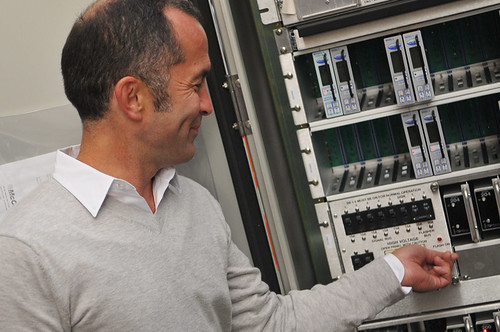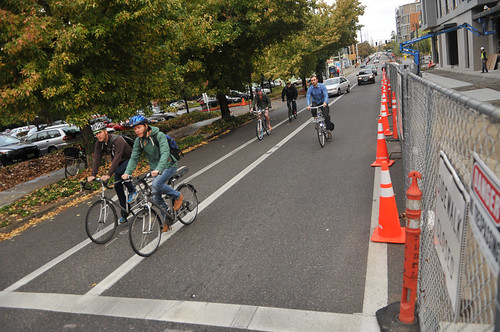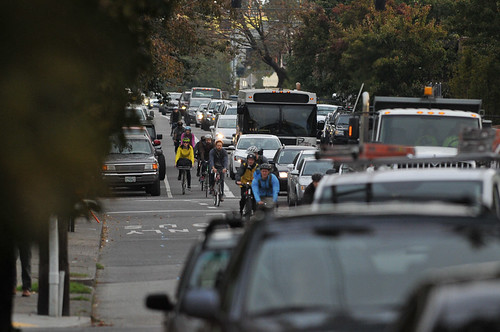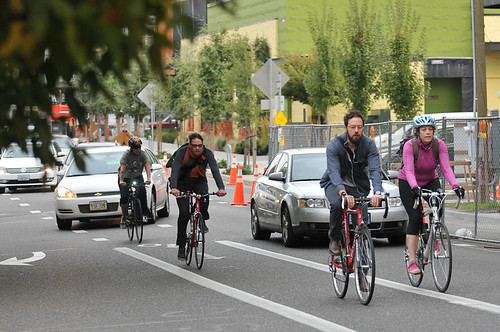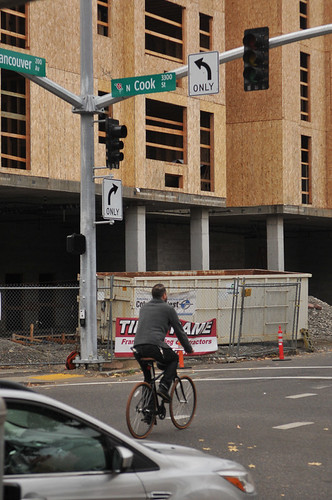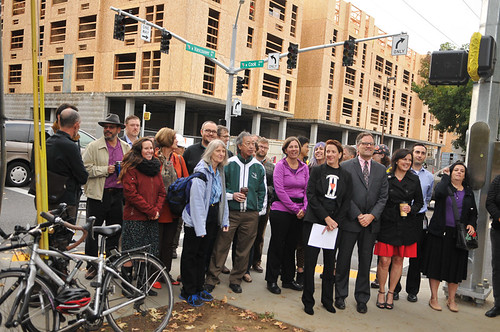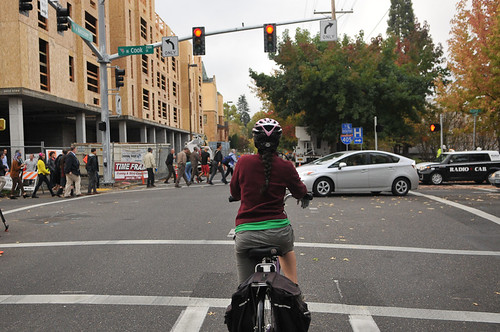
(Photos © J. Maus/BikePortland)
Golden scissors, a red ribbon, coffee and pastries, television cameras and a large crowd that included Bureau of Transportation staff, business owners and neighborhood advocates.
From the looks of this morning’s event at the intersection of North Vancouver and Cook you’d think the city was celebrating the completion of a major project or milestone.

But all this pomp and circumstance was just for a new traffic signal.
Yes, Portland’s wonk-o-meter turned up way past 11 this morning as PBOT Director Leah Treat cut the ribbon and real estate developer Ben Kaiser (sort of sheepishly) flipped a switch to turn on the new signal.
While there was snickering about how the event could have easily passed for a Portlandia episode, there are actually real reasons why this particular new signal warranted such attention.
Vancouver Ave has more daily bike traffic than another other street in city
According to PBOT’s latest bike counts, Vancouver Avenue carries more daily bicycle trips than any other street in the city. Over the past three years an average of 5,000 people on bikes use it every day, making Vancouver the second busiest bikeway overall (behind only the Hawthorne Bridge at 8,000 daily trips).
Vancouver and Cook is a very dangerous intersection
With a freeway offramp that spills into a very busy street that’s adjacent to a grocery store, dense residential development, a hospital and a Red Cross location, this intersection has been a mess for years. With no signal, it was a free-for-all and many people who drive through it demonstrate no regard for the painted crosswalk or the presence of others. PBOT data shows it’s one of the top ten locations for right-hook collisions.
Erik Olson walks across it each morning on his way to work. “Oh good!” he said when I told him what the event was about this morning. “It’s been a challenge to walk to work, there are just too many cars and it’s unregulated,” he addded. “On my way home [northbound] I’ve had to weave between cars just to get across.”
Advertisement
It was paid for by local businesses
“PBOT couldn’t have done this with our own money.”
— Leah Treat, PBOT Director
Calling it a “perfect confluence of interests” PBOT Director Leah Treat wanted everyone to know that this is the first-ever traffic signal in Portland’s history paid for by private businesses through a Local Improvement District (LID). Five local businesses — New Seasons, The Kaiser Group, Owen Gabbert LLC, Legacy Health and the American Red Cross — all chipped to raise over $1 million through the North Vancouver Avenue and Cook Street LID that funded this signal and two others in the area (one at Vancouver and Fremont and another at Cook and Williams)
“PBOT couldn’t have done this with our own money,” Treat said this morning. Andrew Aebi, PBOT’s LID project manager said LIDs are usually formed for things like paving a unpaved road or larger project. Getting businesses to pay for signals “Took a lot of arm-wrestling.”
While these businesses appreciate the safety and livability impact of this signal, their investment wasn’t simply an example of altruism. One of Kaiser’s nearby projects triggered a zoning code change and PBOT mandated the LID as part of signing off on it.
A reaction to rapid pace of nearby development
At the Vancouver/Cook intersection alone there are about 340 new housing units being built. The corridor where this new signal was installed is one of the most rapidly developing areas in the city. These new housing and retail units will add even more traffic volume to nearby streets.
PBOT Director Leah Treat said this morning that as the pace of development increases, “Our responsibility to care for people traveling through this area has increased.” “As a neighborhood develops like this,” she added, “There is mutual interest to do this type of improvement for safety and livability.”
Along with the signal, PBOT is prepping for other changes to the bikeway. By early 2016, they’re planning to restripe the bikeway between Fremont and Cook by adding green “conflict zone” coloration and possibly other changes.
The neighborhood has waited over 40 years for this signal
People who live in the Boise-Eliot neighborhood have been asking for a signal in this location since the Fremont Bridge was built in 1973. Yes you read that right: They’ve waited over 40 years for a safer intersection.
Over the past four decades PBOT has said “we don’t have the money.” But as neighborhood voices rose to power during the city’s North Williams Traffic Safety project back in 2012, it became clear that excuses about funding would no longer suffice.
— Jonathan Maus
jonathan@bikeportland.org
(503) 706-8804
@BikePortland


